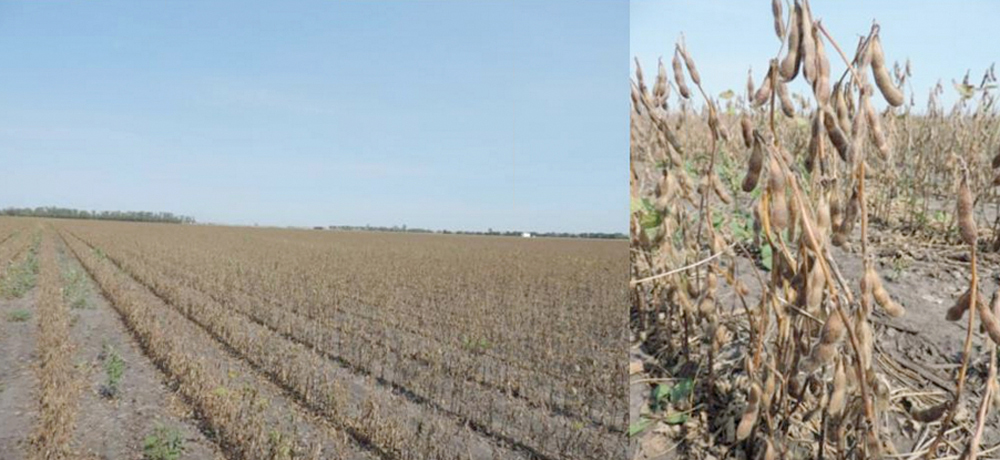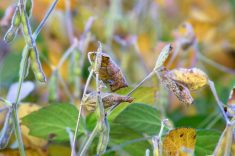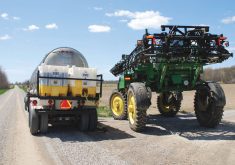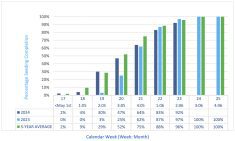Soybean yields are now largely locked in — but quality could still take a hit for future frosts.
Dennis Lange, Manitoba Agriculture pulse crop specialist, says this progress is readily apparent in the province’s record 1.6 million acres of soybeans.
“This year driving around the countryside you are seeing lots of varieties started to dry down and things are moving along quite nicely,” Lange said during the Eastman Crop Talk webinar Sept. 8. “We’ve had lots of heat and ample moisture and for the most part we are looking at no problems with maturity this year.
Read Also

Still hard to predict precise fertilizer payback
Despite decades of advances, international research finds no clear answer for where and when adding nutrient will fail to boost growth.
“If we had a killing frost here tomorrow I think for the most part, most of Manitoba should be OK.”
As of last week most soybeans were in the late R6 to early R7 growth stage.
“If you get frost at the R6 stage it (yield) drops about 20 to 30 per cent,” Lange said. “And once you hit R7 you are talking about a five per cent yield loss. At R7 you have typically mostly yellow to brown pods and very few leaves left.”
Soybeans are mature at R8 when 95 per cent of the pods are brown, leaves are gone and pods rattle when shaken.
Lange spotted one field like that two weeks ago in the Winkler area. Had it not rained Sept. 4 they probably would be in the bin, he added.
Once soybeans reach the 95 per cent brown pod stage they are ready to harvest in 10 to 14 days, Lange said.
While this year most soybean crops matured before frost, there will be years when frost hits early, he said. That’s why it’s important farmers select soybeans appropriate for their area, Lange said. He added it appears Manitoba producers are doing just that.
Of the top 10 most popular varieties grown this year, four are early, four are mid-season and two are late maturing, according to Manitoba Agricultural Services Corporation data.
“It is always really positive to see those early and mid-season varieties,” he said. “It just goes to show that growers are paying attention to those varieties for their growing region.”
Weedy fields
Soybean harvest is just around the corner, but some farmers will have an added challenge with more weeds than normal. Wet weather prevented some farmers from applying herbicides, Lange said. Farmers can make harvest easier by spraying a desiccant, a pre-harvest herbicide or a combination, he said.
Combinations include Heat and glyphosate and glyphosate and Aim (Clean Start).
Lange stressed glyphosate is not a desiccant. It’s a systemic, non-selective herbicide that is taken in by plants killing them. Glyphosate is an effective weed killer, but slow acting.
Diquat is a desiccant with fast plant dry-down but no systemic activity.
It’s critical not to apply harvest aids too early, Lange stressed. Doing so can lead to residual chemicals in soybeans and cut yield.
“The general rule of thumb is to have 80 to 90 per cent leaf drop,” Lange said. “You want most of the leaves to be dropped off. You also want to see the majority of plants has that yellow to brown pods. It is really important to be at that stage.”
Lange said to ensure soybeans are mature enough, check pods in the top four nodes. Make sure they are at least yellow. If there’s a white membrane on the inside of the pods it’s too early to spray, he said.
“If the white membrane is gone you are good to go.”
Farmers will need to pay more attention than ever when spraying soybeans with herbicides in 2017, Lange said. Xtend soybeans, which are tolerant to glyphosate and dicamba, will be commercially available next spring in Manitoba. Roundup Ready 2 soybeans, Liberty Link soybeans and conventional soybeans will all die if sprayed with dicamba, he said.
“Growers are going to have to really pay attention to what is surrounding their soybeans,” he said. “Don’t make the assumption it is the same type of soybean.”
Pod height
Research has shown pod height is not affected by whether soybeans are solid seeded or grown in rows, Lange said. Growing conditions affect pod height and that height can vary year to year with the same variety.
“One of the things I like to encourage growers to do is plant in a timely fashion in the spring,” Lange said. “Some of the fields planted early in the growing season the seed sits in the ground for two or three weeks and the plants come out a little bit slower and in some instances that initial pod set maybe a little lower than what some growers would like.”
Rolling soybean fields can make harvesting low pods easier, he added.
Keeping the cutter knife clean on the combine header helps too.
To help keep soybean pests at bay Lange recommends a one-in-three- or four-year soybean rotation.
“With tighter rotations we may also end up with soybean cyst nematodes,” he warned.
The pest hasn’t been found in Manitoba, but it’s only a matter of time because they are in Pembina County, North Dakota, bordering Manitoba.
“If any growers are looking at purchasing equipment south of the border make sure that equipment is good and clean before bringing it in to Manitoba,” Lange said. “If it is not, find a spot on your yard that is not a heavy-traffic area and clean your equipment thoroughly to make sure that you are not bringing in any unwanted pests.”
Lange is seeing more phytophthora root rot in soybean fields — even with one-in-three-year rotations. Farmers should scout now for the disease, which causes premature plant ripening.
If main soybean stems have soft rot it could be white mould, but if stems from the bottom up are black it could be phytophthora, Lange said.
There are several soybeans listed in Seed Manitoba resistant to different phytophthora races.
White mould was present is some soybeans this year, but generally not enough to make spraying a fungicide economic, he said.
















